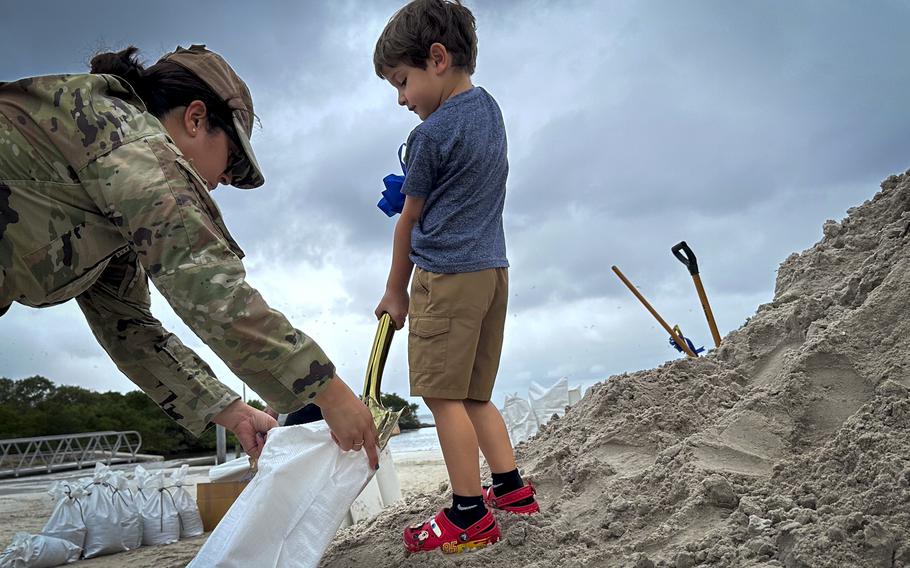.jpg/alternates/LANDSCAPE_910/8683664%201.jpg)
An airman assigned to the 6th Air Refueling Wing fills sandbags with family members Oct. 7, 2024, ahead of Hurricane Milton at MacDill Air Force Base, Fla. (Lauren Cobin/U.S. Air Force)
The Air Force and Navy moved aircraft and ships out of the path of Hurricane Milton on Tuesday as the storm churned toward Florida’s west coast.
State officials also activated Florida’s entire National Guard force in preparation for Milton’s expected landfall as early as late Wednesday in the Tampa area.
MacDill Air Force Base officials closed the major military hub near Tampa to all non-essential personnel on Tuesday after moving its aircraft out of the way of a major storm for the second time in less than two weeks. Navy and Space Force officials said they too were preparing to close bases across Florida and in southeast Georgia in the coming days ahead of Milton’s arrival.
MacDill officials are poised for a direct hit from Milton after avoiding the worst of Hurricane Helene, which made landfall northwest of the Tampa area as a Category 4 storm near Florida’s Big Bend region on Sept. 26. The National Hurricane Center warned Tuesday that Milton could bring up to 12 inches of rainfall and produce a deadly storm surge of 10 to 15 feet in the Tampa area.
Aircraft were relocated from MacDill Air Force Base, including this KC-135 Stratotanker on Oct. 6, 2024, in anticipation of Hurricane Milton. (Sterling Sutton/U.S. Air Force)
Milton, which reached Category 5 on Monday with windspeeds beyond 180 mph, weakened slightly on Tuesday. But hurricane center forecasters expected it to strike Florida as at least an “extremely dangerous” Category 3 storm, and warned Tuesday was the last day Floridians had to prepare for the storm and evacuate. Milton was expected to continue eastward after striking the Tampa area and could remain a Category 1 hurricane Thursday when it arrives in the Jacksonville, Fla., area, forecasters warned.
MacDill’s 6,600 military and civilian personnel have been forced to evacuate several times in recent years, including ahead of Helene last month, Col. Edward Szczepanik, commander of MacDill’s 6th Air Refueling Wing, said Tuesday in a social media post. He instructed the installation’s personnel to take the storm seriously once again, after recent storms — including Helene — left only minor damage on the base.
“Let’s all remember MacDill Air Force Base is not the buildings on the installation,” he said. “The 6th Refueling Wing is our people, our partners and our air power. No matter what happens the next few days, we promise you that we will preserve those three things.”
In addition to the refueling wing, which moved its 12 KC-135 Stratotankers to McConnell Air Force Base in Kansas until the storm’s passing, the 5,700-acre coastal base is home to the headquarters of U.S. Central Command and U.S. Special Operations Command.

An airman assigned to the 6th Air Refueling Wing fills sandbags with family members Oct. 7, 2024, ahead of Hurricane Milton at MacDill Air Force Base, Fla. (Lauren Cobin/U.S. Air Force)
The Navy also acted Monday in preparation of Milton’s arrival, moving dozens of aircraft and at least three ships from its bases near Jacksonville out of the hurricane’s path, service officials said. Three guided-missile destroyers — the USS Donald Cook, the USS Thomas Hudner and the USS Lassen — were sent to sea to avoid Milton. Other ships based at Jacksonville’s Naval Station Mayport — including the destroyer USS Delbert D. Black — were heavy-weather moored in recent days to help them “withstand strong winds and heavy seas” during the storm.
Rear Adm. John Hewitt, the commander of Navy Region Southeast, on Tuesday ordered all Florida Navy bases to prepare to shutdown to non-essential personnel by Tuesday evening. Naval Submarine Base Kings Bay just north of Florida’s border with Georgia on the Atlantic Ocean was also preparing to close Tuesday for the storm, officials said.
“Our foremost concern is the safety of our personnel and their families,” Hewitt said in a statement. “The Navy is fully prepared to protect our people, facilities, and fleet in the face of this storm. I urge everyone to stay vigilant, heed evacuation warnings, and follow the guidance of both civilian and military officials to ensure everyone remains safe.”
The Arleigh Burke-class destroyer USS Lassen and several other ships were ordered to leave Naval Station Mayport ahead of Hurricane Milton. (Alexa H. Trafton/U.S. Navy)
Patrick Space Force Base, near Cape Canaveral, Fla., was set to close to non-essential personnel on Wednesday, officials with base’s Space Launch Delta 45 said.
Meanwhile, the Florida National Guard was bracing for its second response to a major hurricane in two weeks. Gov. Ron DeSantis ordered the entire Florida National Guard to duty on Tuesday to stage in areas from which they can quickly respond, Guard officials said.
The state already had some 1,300 Guard troops on duty responding to Hurricane Helene, but Florida officials warned Monday that Milton could cause more damage in the state, especially because debris from Helene remains scattered throughout several areas.
The Florida Guard was placing liaison officers in some 20 counties to coordinate with local and state officials ahead of Milton. Elsewhere, it was posturing thousands of troops to rapidly provide “search and rescue, route clearance, law enforcement support, commodity distribution, flood mitigation, aviation and other support as needed by the state,” said William Manley, a Florida Guard spokesman. Those troops were outfitted with 12 helicopters, 13 boats and about 440 high-wheeled tactical vehicles, he said.